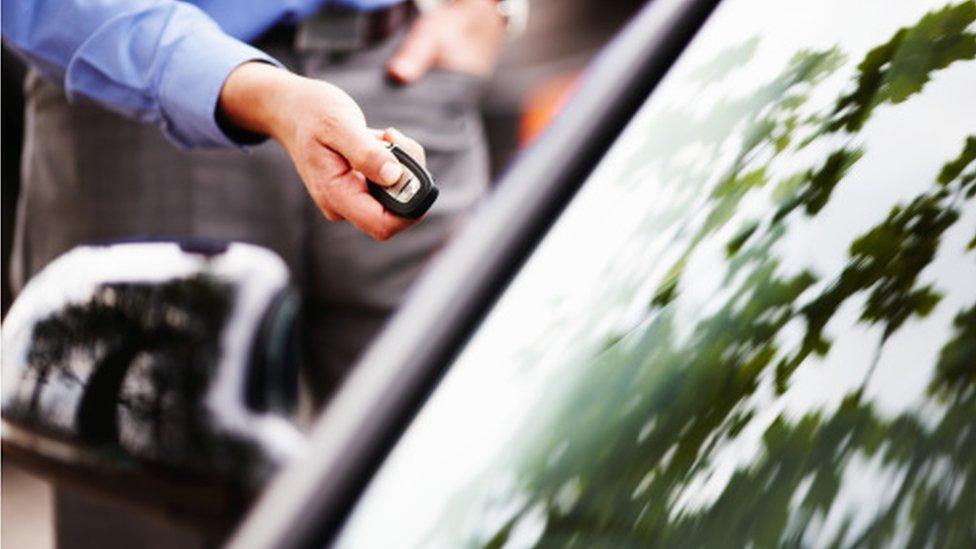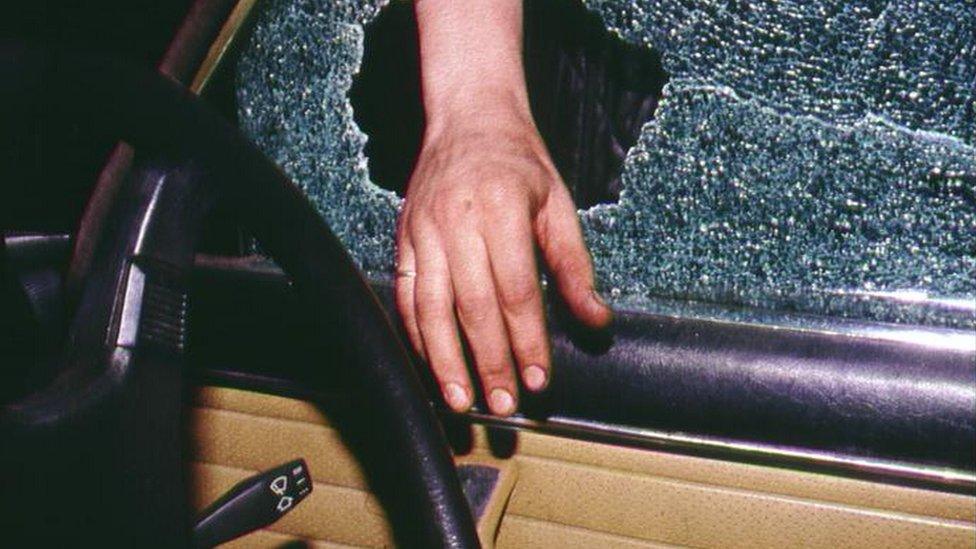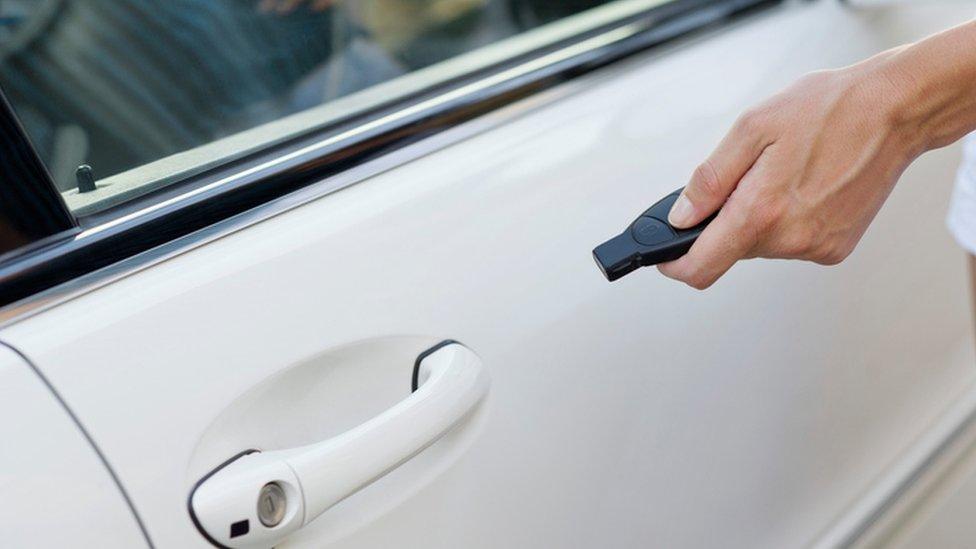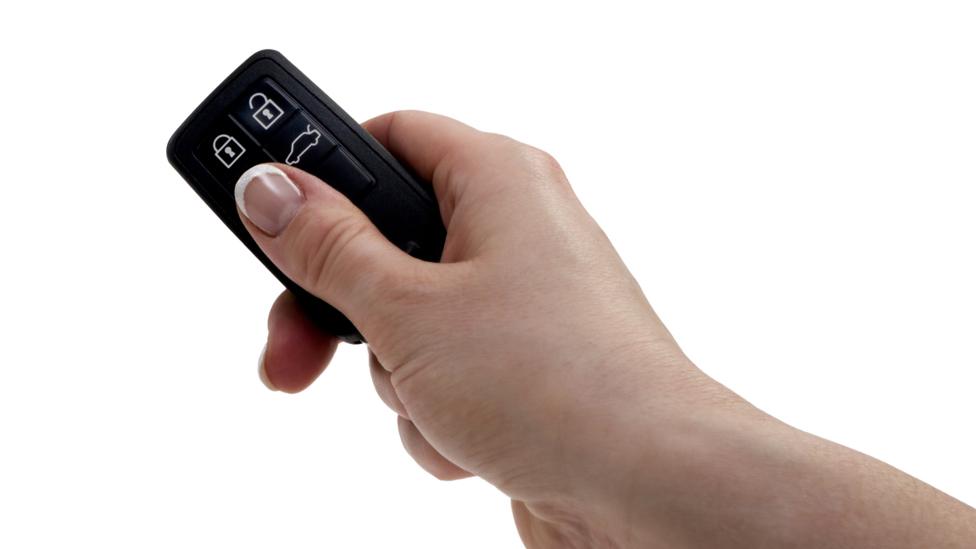Car key jammers: What you need to know
- Published

As reports circulate about tech-savvy thieves using electronic devices - "key jammers" - to prevent cars from locking, what do you need to know about this growing crime?
The transmitters, which are easy to buy online, can be used to interrupt signals from keys fobs, meaning unwary motorists believe their cars to be secure when they're anything but.
This leaves the path clear for thieves to help themselves to your belongings, and even take the car itself.
Relatively low-powered jammers can have a range of about 75m, meaning fairly large areas, such as a whole car park, can be affected at the same time.
But jammer-wielding crooks can strike anywhere, not just public car parks.

Smashing the side window is old hat
Deputy Chief Constable Matt Jukes, from the National Police Chiefs' Council, said although he believes the problem is currently small, it is a "growing feature of vehicle crime".
"The Vehicle Crime Intelligence Unit is working closely and extensively with a number of partners including the Home Office and motor manufacturers on solutions to prevent this crime now and in the future."
Loran Dover got in touch with the BBC to say it happened to her on a residential street in Leeds.
"When I got up and ready for work, I went outside to find all my car doors just placed shut.
"I was mortified to think I'd left my car like this, when I knew I locked it - I was staying at my boyfriend's house and had to leave Christmas presents in the car. But then when we actually looked inside the car, the whole car had been rifled through and anything of value taken.
"Police at first said there was nothing they'd do. Not even send anybody to check for fingerprints because there was no clear sign of a break-in. But when I phoned my bank to cancel my card, the thieves had been using my contactless. That's when the police actually got involved and took it more seriously.
"They are currently looking at CCTV so hopefully they will catch them."

How can you make sure your car is safe?
The only sure way to know your car is locked is to check manually. Most cars have another indication the lock has been deployed, such as the indicator lights flashing, wing mirrors drawing in, or the horn giving a short toot.
If you're close enough to the car you can also hear the central locking clunk into place.
Deputy Chief Constable Jukes adds: "It is essential that people remain vigilant against this kind of electronic breach.
"We urge people to keep a close watch on their cars and possessions so as not to offer any incentives to criminals, including manually checking that the vehicle is locked and taking any valuables with you when leaving the vehicle unattended."
A more hi-tech approach to securing your vehicle might be to invest in a car jamming detector, a device that sets off an alarm when a blocking signal is detected.
Will insurance companies pay out for such thefts?
Ms Dover highlights one problem faced by victims - not only are they deprived of their belongings, but there is no proof they've not simply forgotten to lock their cars. And most insurance companies will not pay out if the car has been left unattended and unlocked.
According to the Financial Ombudsman, many insurers exclude cover for theft if the vehicle was left unlocked and unattended.
The only way to prove a car lock was jammed is if a thief is caught red-handed, although patterns of theft can be strong indications.
For example, Thames Valley Police is investigating 14 recent thefts from lorries, vans and cars with "no obvious sign of a break-in".
All of the thefts took place at service stations on the M4 in Berkshire in the last two weeks of November.
Is my car itself safe?
Not necessarily.
The Met police force warns an increasing number of electronically controlled vehicles are being taken by criminals exploiting their electronics.
Once inside the vehicle, the thieves plug a device into the on-board diagnostic port (OBD) which allows them to download the vehicle's electronic information on to a blank key. This key is then compatible with the car, allowing them to drive the vehicle away.
This process can take just seconds.
The Organised Vehicle Crime Unit recommends using a steering wheel lock or gearstick lock and to consider having an OBD lock and a tracker fitted.
- Published3 December 2016
